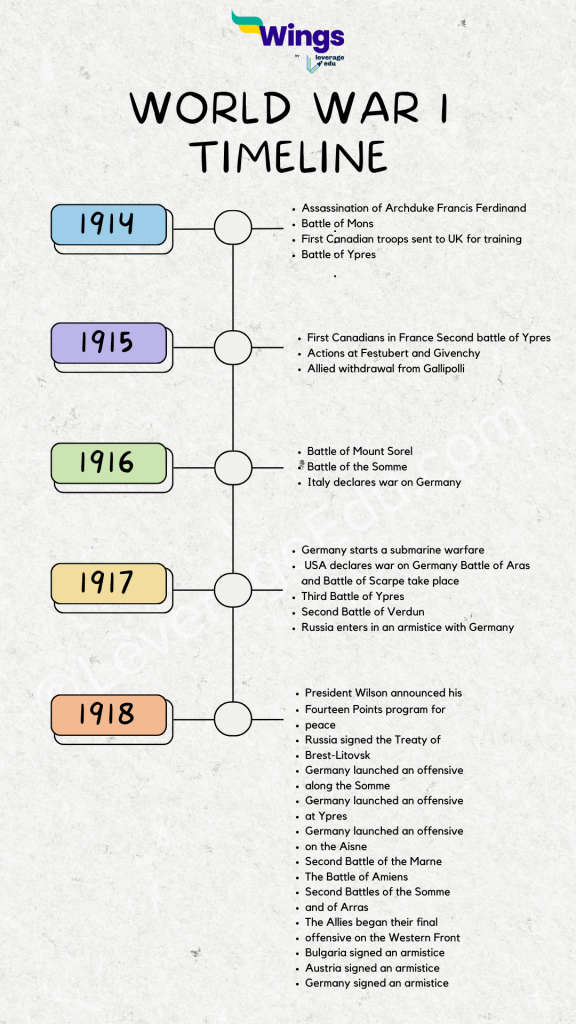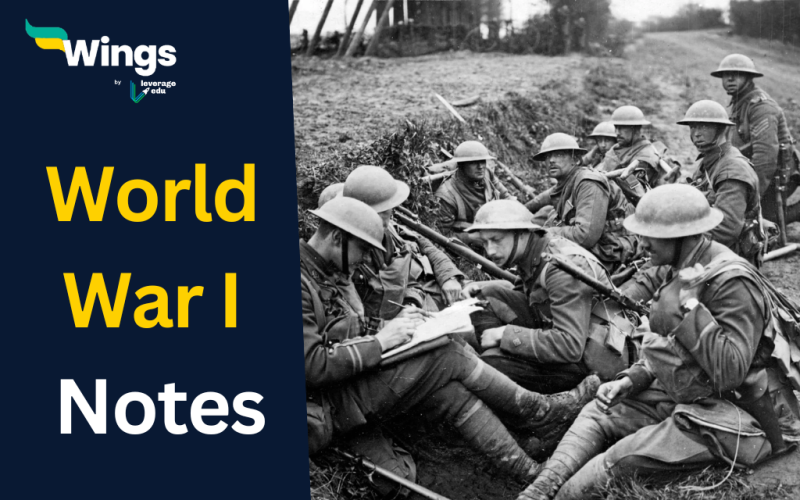Hey, guys! Mr. Owl 🦉 is here. I see that you need ‘World War 1 Notes’ Hootfully, I’ll be of help to you! Since we owls are very wise. If you scroll further down this blog, you’ll see all the information you will need!
Imagine the world in turmoil, where the great powers are divided into two opposing camps, alliances formed out of suspicion and tension. Welcome to the dramatic and crucial era of World War 1, often known as the First World War. This blog is your key to unlocking the history and causes of this monumental conflict.
WW1 is an essential portion of the history syllabus for UPSC, Banking, Management and Defence exams. UPSC Preliminary and UPSC Mains Exams often contain questions related to World War 1.
Table of Contents
⚔️ When did World War 1 start?
World War 1 started on July 28, 1914, and ended on November 11, 1918. The war had raged for over 4 years, taking a tremendous toll on nations and individuals. The Allies, consisting of the British Empire, France, and the Russian Empire, faced off against the Central Powers, primarily Germany and Austria-Hungary.
📅 World War 1 Timeline
To get a detailed outlook on the World War 1 timeline and events that happened download the pdf given below.
Students can also download the World War 1 Timeline – WW1 Timeline PDF

📌 Causes of World War 1
Now, let’s understand the causes of World War 1, a colossal conflict that changed the trajectory of many countries:
- Conflict between Imperialist countries: Imagine it as nations racing to grab a piece of the pie. Old imperialist countries like Britain and France competed with new imperialist countries, like Germany, over resources and territory.
- Ultra Nationalism: Think of it like intense patriotism on steroids. Movements like Pan-Slav and Pan-German added fuel to the fire.
- Military Alliances: Picture a web of alliances being woven. Triple Alliance (Germany, Italy, Austria-Hungary) and Triple Entente (Britain, France, Russia) were the key players, but the game changed as more nations joined in.
- International Anarchy: It’s like a free-for-all, with secret agreements and disputes. Britain and France made deals, but Germany had objections.
- Balkan Wars: The Balkans were like a powder keg, with many nations under Turkish control. When they rebelled, Germany and others got involved.
- Alsace-Loraine: Imagine a territorial tug-of-war between Germany and France over Alsace-Lorraine.
- Immediate Cause: Picture a single spark setting off an explosive chain reaction. The assassination of Archduke Francis Ferdinand by a Serbian native triggered Austria’s declaration of war on Serbia.
Must Read: What Is Nationalism? Definition, History, and Significance
🌎 Countries Involved in World War 1
World War 1 involved a vast array of nations, creating a complex and interconnected web of alliances and enmities. The major countries involved in World War 1 included:
- Allies: This group was primarily composed of the British Empire, France, and the Russian Empire. They were later joined by the United States, Japan, and various other nations. The Allies were driven by a common goal to oppose the Central Powers.
- Central Powers: The Central Powers were led by Germany and Austria-Hungary. They were later joined by the Ottoman Empire and Bulgaria. These countries formed their alliance to counter the growing influence of the Allies.
- Other Participants: Beyond the major powers, numerous other nations were drawn into the war, often due to their colonial or territorial interests. These included Italy, which initially joined the Central Powers but later switched sides, as well as smaller nations like Belgium, Serbia, and many more.
Also Read: Arab Nationalism: Rise, Fall and Objective
🇮🇳 India in World War 1: Role and Significance
India’s role in World War 1 was significant and multi-faceted, delving deeper into which reveals the extent of its contribution:
- Troop Contribution: India provided a vast number of troops, often referred to as the “Indian Expeditionary Force.”
- Sacrifice: The Indian Army’s contribution came at a great cost. Approximately 62,000 Indian soldiers lost their lives, and another 67,000 were wounded in the line of duty.
- Diversity: India’s participation highlighted its incredible diversity. Soldiers from different regions, religions, and backgrounds joined the war effort, reflecting the unity of purpose that transcended cultural differences.
- Impact on India: World War 1 had far-reaching consequences for India. The war experience, coupled with India’s significant contribution, played a role in shaping the country’s future. It contributed to a growing desire for self-determination and independence from British colonial rule.
- Legacy: The role of Indian soldiers in World War 1 is a significant part of India’s history, and their contributions are commemorated in memorials and records.
India’s participation in World War 1 was more than just a footnote in history; it was a vital chapter that showcased the strength and resilience of the Indian people and had lasting effects on the trajectory of the nation’s future.
Did You Know: Several men lied about their age so that they could participate in World War 1. The youngest soldier in WWI was 12 years old, his name was Sidney Lewis
Consequences of World War 1
The consequences of World War 1 were profound and far-reaching, reshaping the course of history in numerous ways. Here are some of the key consequences:
- Human Casualties: World War 1 resulted in a staggering loss of life. Approximately 16 million people, both military and civilian, lost their lives.
- Destruction and Economic Impact: The cost of the war was astronomical, draining the treasuries of many nations. It led to severe economic challenges, including inflation and unemployment.
- Political Changes: The war brought about significant political changes. Several empires, including the Austro-Hungarian, Ottoman, and Russian Empires, disintegrated. New nations emerged, and borders were redrawn. The Russian Revolution of 1917 led to the establishment of a communist government, and the collapse of empires gave rise to nationalist movements.
- The Treaty of Versailles: The Treaty of Versailles, signed in 1919, officially ended the state of war between Germany and the Allied Powers. It imposed harsh penalties on Germany, including territorial losses, disarmament, and reparations. The treaty’s punitive nature sowed the seeds for future conflicts and resentment in Germany.
- The League of Nations: In an attempt to prevent future conflicts, the League of Nations was established as an international organisation. While it aimed to promote peace and cooperation among nations, it proved ineffective in preventing World War 2.
- Social and Cultural Changes: The war brought about significant social changes. Women’s roles in society began to shift as they took on more responsibilities while men were at the front. The war also had a profound impact on art, literature, and culture, giving rise to the “Lost Generation” of writers and artists.
- Technological Advancements: World War 1 saw the use of new technologies, such as tanks, chemical warfare, and aeroplanes, which would play a major role in future conflicts. These innovations changed the face of modern warfare.
- Shift in Colonial Empires: The war weakened the colonial empires of European powers. Colonised peoples began to demand greater independence and self-determination, leading to movements for decolonization in the post-war period.
- Economic Changes: The war accelerated industrialization and economic growth in some nations, such as the United States, as they supplied goods to the warring powers. This contributed to a shift in economic power.
- Seeds of Future Conflicts: The unresolved issues and territorial disputes left by the war, coupled with the harsh terms of the Treaty of Versailles, set the stage for future conflicts, ultimately leading to World War 2.
“Kiddos, I’ve answered all your queries with the utmost precision that I was capable of. Now, I’ll be taking my leave, but if you think I might have missed something, do check out the FAQ section or drop a comment. I always respond!”
FAQs
The assassination of Archduke Francis Ferdinand of Austria-Hungary by a Serbian native in 1914 acted as the spark that ignited the war, setting off a chain reaction of events.
Military alliances, like the Triple Alliance and Triple Entente, created a web of obligations and brought multiple nations into the conflict when one member was attacked, thus escalating the war.
India contributed over a million troops to the war effort, serving in various theatres and making a significant sacrifice, with 62,000 soldiers losing their lives and another 67,000 wounded.
RELATED BLOGS
In summary, World War 1, with its complex web of alliances and deep-rooted causes, reshaped the course of history. This blog, designed for students preparing for competitive exams, offers a concise and comprehensible glimpse into this pivotal period.
Hope you have gotten all the relevant information about ‘World War 1’! If you want to know more about topics like this, then visit our general knowledge page! Alternatively, you can also read our blog on general knowledge for competitive exams!
 One app for all your study abroad needs
One app for all your study abroad needs













